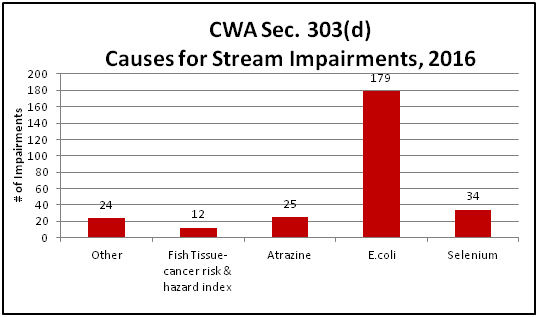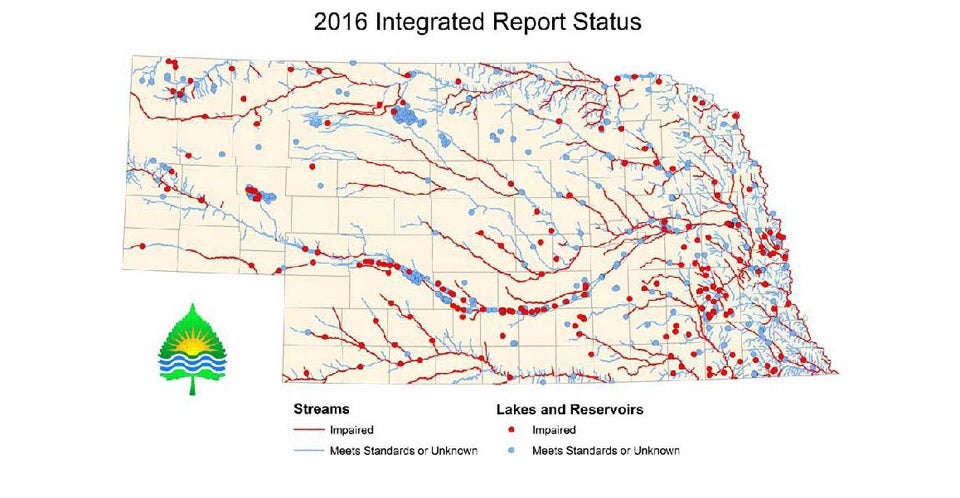March 2016 Metrics Report









The graphs to the left show the major sources of water quality impairments to Nebraska’s streams and lakes*.
Surface water quality data collected by the state and its partners is assessed to determine if water bodies have adequate quality to meet or surpass state standards. The streams or lakes not meeting standards are “impaired”, which triggers a determination of the pollution reduction needed to meet standards. Ultimately, watershed plans become projects with on-the-ground activities (for example: buffer strips, terraces, no-till, bank stabilization). Most impairments in Nebraska are from nonpoint sources of pollution.
Please note that one waterbody can have multiple impairments and some impairments are based on fish tissue analysis.
| 2016 | Streams & Rivers | Lakes & Reservoirs |
| Total number | 1558 stream segments | 539 lakes |
| % Assessed | 36% | 59.7% |
| % Assessed Waters Impaired | 48.5% | 60% |
*Every even numbered year, NDEQ issues the “Integrated Report”, which is required by the federal Clean Water Act (CWA) Section 303(d). The 2016 Integrated Report will be published when approved by EPA (expected in May).


Following is a description of specific issues NDEQ has been addressing in March:
Emerging Risks / Issues: Historic burning of prairies in the Flint Hills of Kansas have presented air quality challenges to Nebraska. Increased levels of particulate matter and ozone have adversely impacted Nebraska. The State of Kansas has developed the Flint Hills Smoke Management Plan in an attempt to balance the need to burn prairies without adversely impacting downwind communities. The Plan is applicable to prescribed burns. NDEQ’s counterparts in Kansas are providing weekly notifications of when and where burning is conducted. NDEQ began receiving reports from Kansas on March 1st. On April 5th the Dept. was contacted by a constituent who indicated there was a haze that was particularly heavy between Mason City and Litchfield. The Flint Hills burning could be contributing factor to this haze.
On March 2nd NDEQ received a report of a catastrophic failure of a large liquid fertilizer storage tank at Farmers Coop in Dorchester. The NDEQ Emergency Response Team responded and found there had been a release of 165,000 gallons of 10-32-0 fertilizer. The sudden nature of the release caused a surge of fertilizer to overwhelm the secondary containment. Subsequent clean-up resulted in the recovery of a substantial amount of the product which will be used as fertilizer. Over 1,400 tons of impacted soil was excavated and taken to the Milford landfill. The Groundwater Unit is assessing the need to implement a groundwater monitoring program at the site and will ensure clean-up is conducted properly.
Accomplishments: The Southeast Nebraska Planning, Exercising and Training Region hosted a tabletop exercise on how to respond to an Avian Influenza outbreak. A number of state and local agencies participated including NDEQ staff with experience in the outbreak in Northeast Nebraska in the spring of 2015.
Misc. Items of Note: The Environmental Quality Council met on March 22nd and approved changes related to hazardous waste management regulations. A number of procedural changes were proposed and approved which will facilitate the management of hazardous waste with no decrease in environmental protection.
NDEQ has initiated programmatic work plans outlining duties/expectations for 2016. The work plans will be used in support of the agency monthly performance metric reports. Additionally, the work plans will be used to support annual performance evaluations, annual staff expectations and performance measures.